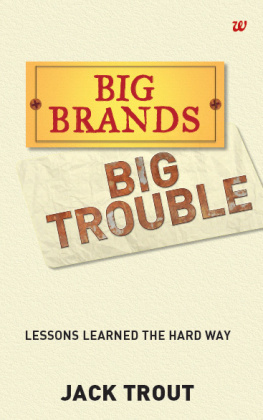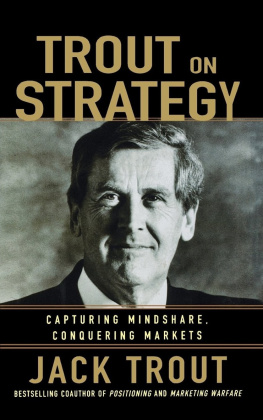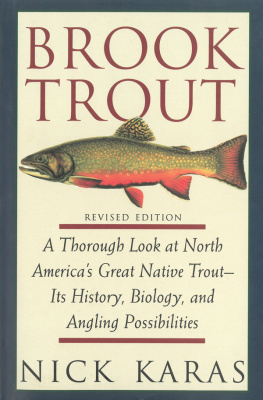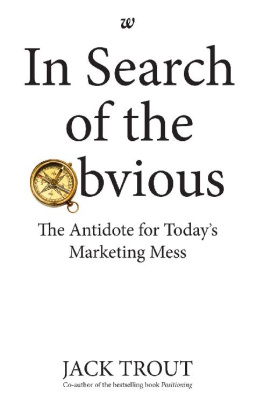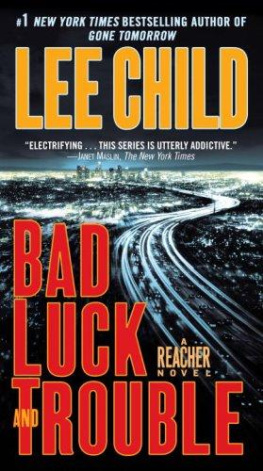BIG BRANDS
BIG TROUBLE
Jack Trout is President of Trout and Partners, one of the most prestigious marketing firms in the United States, with offices in twenty countries. His client list includes Southwest Airlines, IBM, Merrill Lynch, Sears and the US State Department. He is the author of several marketing classics, including In Search of the Obvious and Differentiate or Die . For more information, please visit www.troutandpartners.com.
BIG BRANDS
BIG TROUBLE
Lessons Learned
the Hard Way
JACK TROUT
westland ltd
61, 2nd Floor, Silverline Building, Alapakkam Main Road, Maduravoyal,
Chennai 600 095
93, 1st Floor, Sham Lal Road, Daryaganj, New Delhi 110 002
First published in India by EastWest Books in 2003
Second Edition published in India by westland ltd 2011
This edition published in India by westland ltd 2015
Copyright Jack Trout 2001
All rights reserved
10 9 8 7 6 5 4 3 2 1
ISBN: 978-93-85724-66-4
Typeset by PrePSol Enterprises Pvt. Ltd.
Printed at xxx
Due care and diligence has been taken while editing and printing the book. Neither the author, publisher nor the printer of the book hold any responsibility for any mistake that may have crept in inadvertently. Westland Ltd, the Publisher and the printers will be free from any liability for damages and losses of any nature arising from or related to the content. All disputes are subject to the jurisdiction of competent courts in Chennai.
CONTENTS
PREFACE
I n recent years, business executives have been more in search of role models than ever before. Tom Peters probably gave this trend a giant boost with the very successful book he co
authored In Search of Excellence (Harper & Row, 1982).
Excellence, as defined in that book, didnt equal longevity, however; many of the role models offered there have since foundered.
The book was based on a McKinsey research study of 75 highly regarded companies and involved extensive structured interviews as well as a 25-year literature review. To qualify as excellent, each top performer had to score well over the long haul in both growth and economic health. But not many years after this widely popular book was published, many of those excellent performers were in trouble, including companies like Digital Equipment, IBM, Data General, Kmart, and Kodak. In retrospect, a better title for the book might have been In Search of Strategy.
The lessons that emerged were staples as traditional as mother
hood and apple pie: Stay close to the customer; hold fast to the values of entrepreneurship; find productivity through people; be hands on and value driven; stick to your knitting. (You get the idea.) One of my favorite truisms was a bias for action. A senior Digital Equipment Corporation executive was quoted thus, When weve got a big problem here, we grab ten senior guys and stick them in a room for a week. They come up with the answer and implement it. But, it later turned out that they were coming up with the wrong answers. So much for the ten guys in a room lesson.
And later books by Tom Peters may not give you much more guidance either. As a Fortune article commented, Because the more one talks to Peters, the more one recognizes that Peters, through the 1990s, has spent more and more time talking about gifted freaks, examples that are impossible to emulate (November 13, 2000).
More recently, the popular method-by-example book has been Built To Last (HarperCollins, 1994), by James Collins and Jerry Porras. In it, they write glowingly about Big Hairy Audacious Goals that turned the likes of Boeing, Wal-Mart, General Electric, IBM, and others into the successful giants they have become.
The companies that the authors of Built To Last suggest for emulation were founded from 1812 (Citicorp) to 1945 (Wal-Mart). These firms didnt have to deal with the intense competition in todays global economy. While there is much you can learn from their success, they had the luxury of growing up when business life was a lot simpler. As a result, these role models are not very useful for companies today.
I have a better approach.
Not only is learning from failure easier, it offers a more thorough analysis of what works and what doesnt. We have always been taught that we should learn from our mistakes. Looking at the downs alongside the ups in the lives of the superbrands can show you what commonly goes wrong. There is no shortage of companies that recently have moved from glory days to difficult days.
Readers of my previous books may recognize some of the companies that form the case studies. While Ive written about these companies before, this time around I put them under a microscope to draw out the underlying reasons for their difficulties and to suggest some things that could have been done to save them.
Within these stories, I describe some personal experiences for the first time. This isnt a tell-all book, but it uses candid analysis to help readers understand how easy it is for things to start down a road that puts a rich, successful company into big trouble.
And big trouble isnt easy to fix.
Chapter
The Most Popular Mistakes and Their High Cost
L ong ago and far away, I started my career at General Electric. It was the early 1960s and, in hindsight, it was a wonderful time. Competition, as we know it, just didnt exist.
GEs main full-line competitor was a company called Westing-house, but by todays standards, it was barely a real one. Westing-house was a player, but GE actually saw the company more as a necessity. If that competition ever went away, the government would pounce on GE to break its hold on electricity.
Back then, nobody really worried much about mistakes because CEOs figured they would be able to get any lost business back in the end. (Jack Welch hadnt yet arrived ar GE. After he took over, everyone worried a lot more about mistakes.)
Whats Changed
Today there are so many competitors that they quickly take your business if you make a mistake. Your chances of getting it back are slim unless someone else in turn makes a mistake. Hoping for competitors to make mistakes is like running a race with the hope that other racers will fall down. It isnt a very smart strategy.
Even worse is the large number of participants in each race. Every category is haunted by what I call the tyranny of choice. Consumers have so many choices that one false step brings not just one, but an army of competitors to take advantage of your misstep. And whats especially tragic is that you dont get that business back. Its gone. (The General Motors story in Chapter 2 dramatizes this problem.)
In the following chapters, there are details about a lot of mistakes and the high cost that companies paid for making them. But before wheeling in the big brands, it is helpful to look at the most prevalent blunders in our hypercompetitive world and hint at the lessons they provide.
The Me-too Mistake
Many people believe that the basic issue in marketing is convincing the prospect that they have a better product or service. They say to themselves, We might not be first but were going to be better.
That may be true, but if youre late into a market space and have to do battle with large, well-established competitors, then your marketing strategy is probably faulty. Me-too just wont cut it.
Consider the efforts of Pepsi in the lemon-lime category. Even though supermarket soda aisles are overcrowded and sales growth is flat, Pepsi is launching Sierra Mist, a competitor to Sprite and 7UP. This is after two failed prior attempts (Slice and a product called Storm).


